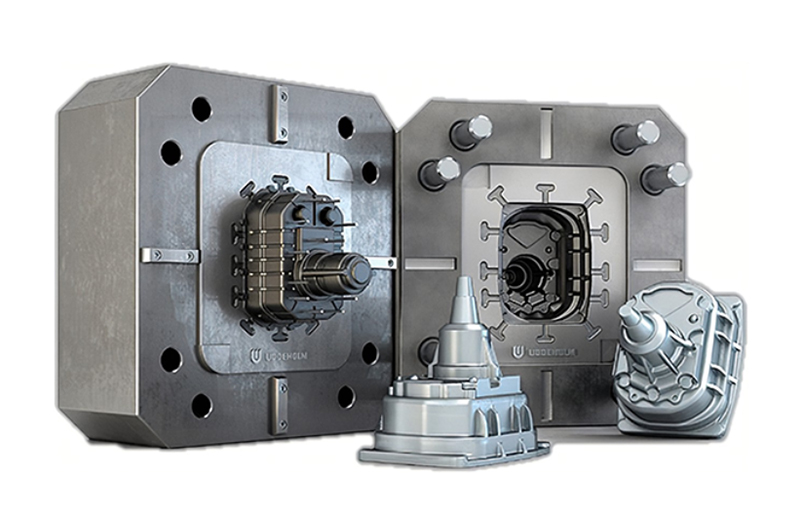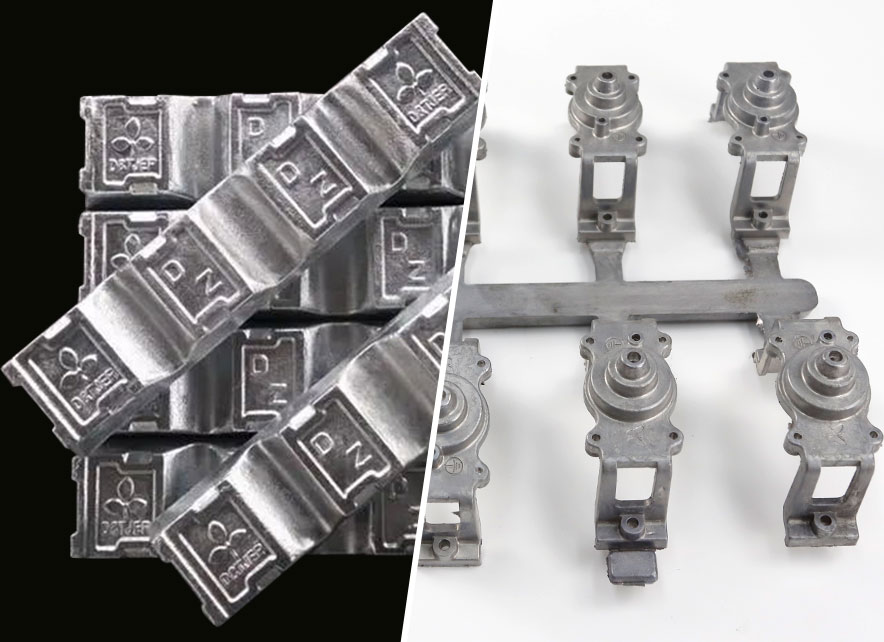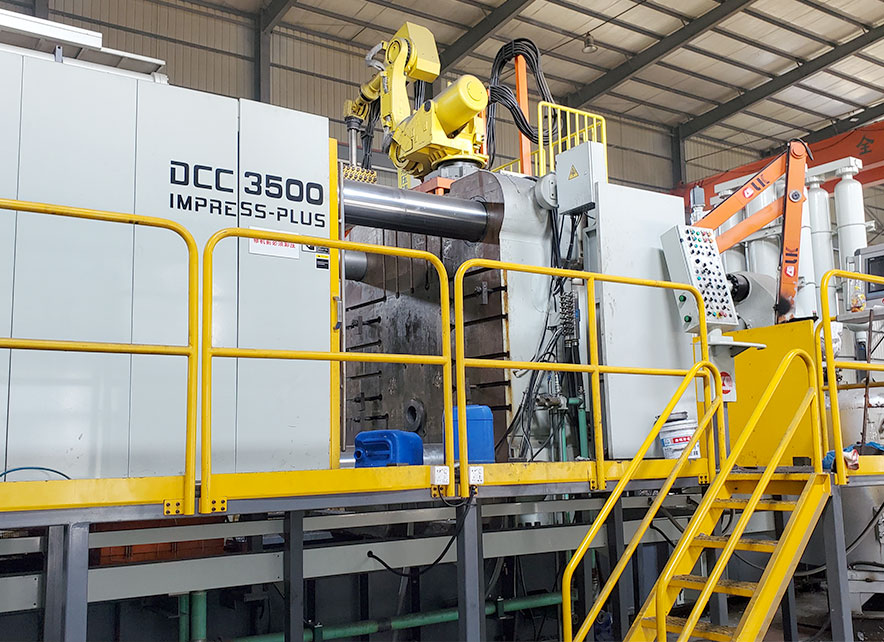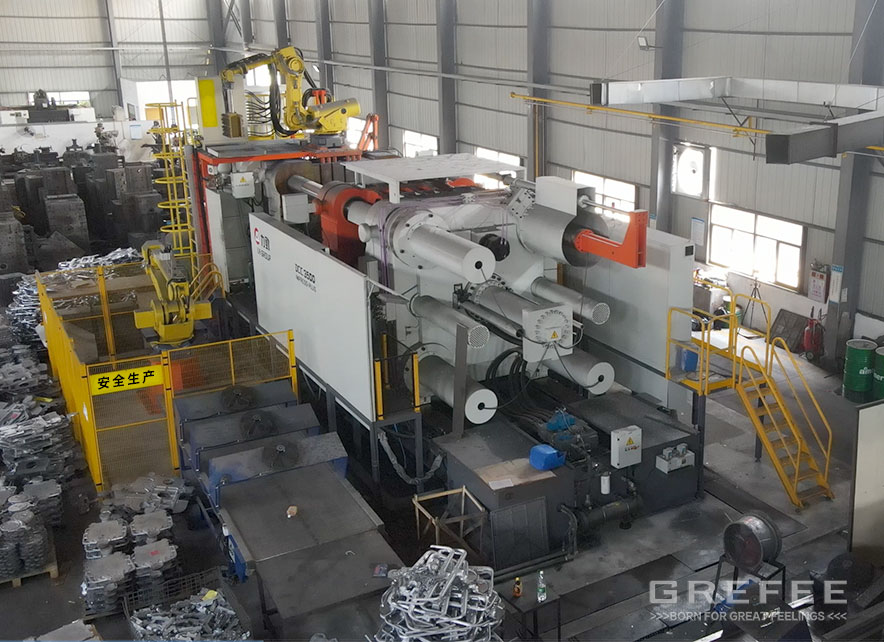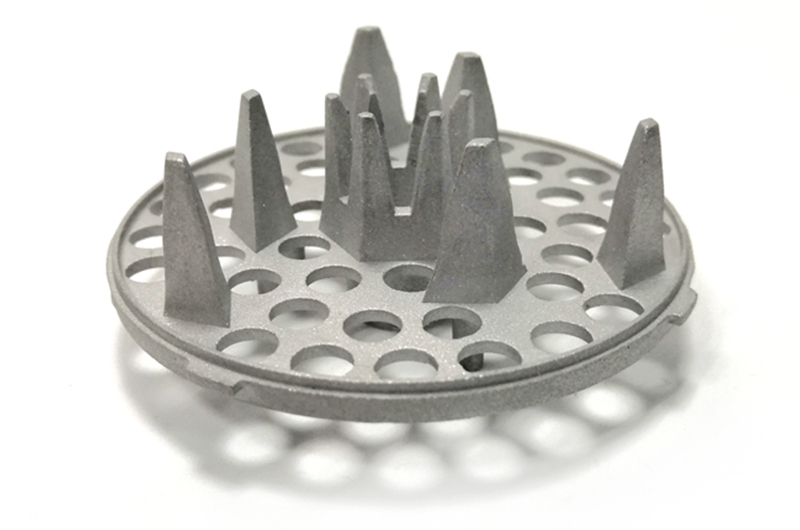Material selection for die cast metals
Aluminum alloy die casting, Magnesium alloy die casting, Zinc alloy die casting

Posted on : June 24, 2022 By GREFEE
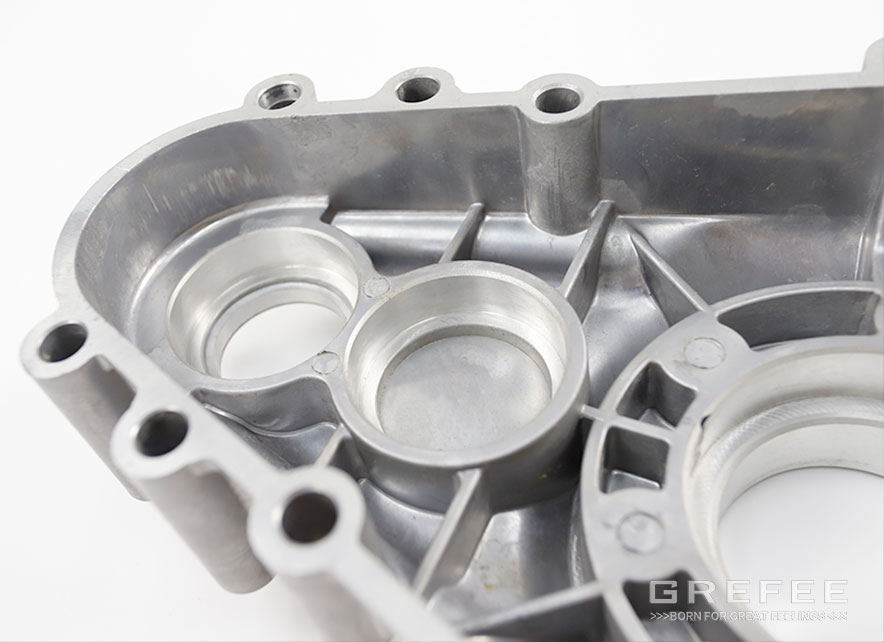
Common metal die casting materials are various, such as aluminum alloy, magnesium alloy, zinc alloy, etc. Each material has different properties. According to the difficulty level of different cast parts, the cost spent on producing different materials vary greatly. Magnesium alloy castings ranks the highest among these three die cast metals due to its material cost and casting difficulties. However, not the most expensive one is the optimal. We should consider the real situation in production to make the best choice in selecting material.
Magnesium alloy casting
Magnesium is a flammable and low-density metal due to its physical and chemical properties. Its density is 1.738g/cm3 at 20℃. The data for liquid magnesium is 1.58g/cm3. Under the standard atmospheric pressure, the melting point for it is 650±1)℃ and boiling point is 1090℃. When it is heated in the air, it starts burning from 632℃~635℃. Therefore, this determines the preparation and alloy smelting process magnesium are complex. The purity of the industrial used magnesium can be as high as 99.9% but not for structural materials. The magnesium alloys contain aluminum, zinc, lithium, manganese, zirconium and rare earth elements have higher strength. Currently, the most frequently used is the magnesium aluminum alloy, followed by magnesium manganese alloy and magnesium-zinc zirconium alloy, which are mainly used in industrial sectors like aviation, aerospace, transportation, chemical industry, rocket, etc.
1. Properties of magnesium alloy
light weight:The specification of aluminum alloy is 2.7G/CM3, and that for magnesium is only about 1.8G/CM3 which is 30% lower than the aluminum alloy and 80% lower than the steel. Thus, magnesium alloy has turned to be the best material for the fabrication of automotive and portable electronic products.
strength:Among the industrial materials, like metals and plastics, the magnesium alloy has excellent strength to weight ratio. Its yielding strength is 160MPa and tensile strength is 240MPa.
Die casting property:With good structural conditions, the magnesium alloy allows the wall thickness of cast parts be as less as 0.6mm, which is unavailable in plastic under the same strength degree. The die casting property of aluminum alloy is practicable when the data is higher than 1.2-1.5mm. compared to aluminum, the magnesium alloys are easy to be formed, so it suits large volume production(production rate can be 1.5 times that aluminum). moreover, the wear resistance of the magnesium alloy is the lower than that of aluminum due to its low viscosity.
Shock absorption:Magnesium is known for its excellent hysteretic shock absorption performance that can effectively absorb the shock and noise, suiting for the fabricate of equipment shells as its great performance in the reduction of the noice transmission, anti-impact, and the prevention of the depression due to the external force.
Rigidity:The rigidity of magnesium is two times that of aluminum and much higher than most plastics and rubbers. Its great performance in the stress resistance makes the magnesium the first material choice for a number of casting components.
High EMI barrier:Magnesium alloy has good Electromagnetic wave blocking performance, suiting for the fabrication of electronic products.
Good cutting performance:Compared to the aluminum and zinc, magnesium has better cutting performance, making it a great metal material for cutting.
The specific heat capacity of the magnesium alloy is low but the cooling speed of the alloy liquid is fast.
Magnesium alloy is not adhesive to the mold steel material.
2. Advantages of magnesium alloy materials
light weight:The specification of the magnesium alloy is the lowest among all the structural use alloys, which is 68% of aluminum alloy, 27% of zinc alloy, 23% of steel. Except for the use for production the shells of 3C products and internal structural parts, magnesium is also a great material for the casting components in automotive, airplanes, etc.
Higher specific strength and stiffness:The specific strength of magnesium alloy is obviously higher than aluminum alloy and steel. Its specific rigidity is almost equal to aluminum alloy and steel but much higher than the industrial plastic, which is 10 times that of general plastic.
Good vibration resistance:Under the same load, its shock absorption is 100 times that of aluminum and 300~500 times that of titanium alloy.
Good electromagnetic shielding:The shells of 3C products are required to provide excellent anti-electromagnetic protection. The magnesium alloy shell can completely absorb the electromagnetic interference with the frequency of more than 100dB.
Good heat dissipation:typically, the thermal conductivity of metal is hundred times that of plastics. The figure for the magnesium alloy is slightly lower than the aluminum alloy and copper alloy but much higher than titanium alloy. Its specific heat is almost equal to water, which is the highest among all the common used metals.
Good texture:The appearance and touch texture of magnesium alloy are excellent, making the product more luxurious.
Good recyclability:4% of the price of new material can recycle the magnesium alloy products and wastes.
Stable resource provision:The storage of the magnesium element ranks at the 8th in the crust. Most of the magnesium comes from the sea water, so its resource is stable and sufficient.
3. advantages of magnesium alloy die casting
- High productivity
- High precision
- Good surface quality
- Fine casting grain
- applicable to products with thin wall and complex structure
4. Comparison between the magnesium alloy die casting and aluminum alloy die casting
- 50% higher productivity
- Use steel formwork to extend service life
- Lower latent heat, energy saving
- Good machinability
- 50% of mold cost savings
- The melt has higher fluidity
5. Disadvantages of magnesium alloy die casting
Since the extremely high liquid filling and solidifying velocity probably cause the air trapping, so the feeding, ventilation and cold material treatment are essential.
The wall thickness of castings should not be too thick, and should be controlled within a certain dimension.
Cheap die casting alloy with limited mechanical properties.
Limited use of various die casting alloys, such as the AZ91D is typically used in the mobile industry.
Due to the small size of the casting grains, so the creep resistance is poor.
The casting property of the Mg-Al-RE magnesium alloy with creep resistance is poor and the material is of high cost.
Thermal treatment is not compatible.
Not applicable to the welding, needing the use of the protective gas.
Aluminum alloy die cast
1. Aluminum alloy
Aluminum alloy is the generic for the aluminum based alloys, including alloy elements, copper, silicon, magnesium, zinc, manganese, and secondary alloy elements include nickel, iron, titanium, chromium, lithium, etc. The density of aluminum alloy is low but is higher in the specific strength, which is close or exceeds the fine steel. Its great plasticity can be processed into any types of profiles with great electric conductivity, thermal conductivity, and corrosion resistance. The edges of aluminum die makes it being widely used in different industries. The consumption of it is second to the steel.
2. Classification of aluminum alloy
Aluminum alloy has two types: casted aluminum alloy, which is used being casted. Deformed aluminum alloy that can bear pressure machining, of which the mechanical properties is higher than as cast. It can be processed into aluminum alloy materials of various shapes and specifications, and is mainly used for manufacturing aviation equipment, daily necessities, building doors and windows, etc.
3 .Machining methods of aluminum alloy
Aluminum alloy can be divided into deformed aluminum alloy and cast aluminum alloy according to processing methods. Wrought aluminum alloys includes non heat treatable and heat treatable strengthened aluminum alloys. The non heat treatable reinforced type can not improve the mechanical properties through heat treatment, but can only be strengthened through cold working deformation. It mainly includes high-purity aluminum, industrial high-purity aluminum, industrial pure aluminum and antirust aluminum. The mechanical properties of heat treatable strengthened aluminum alloys can be improved by heat treatment, such as quenching and aging. The common method is the aluminum hot chamber die casting. It has hard aluminum, forged aluminum, super-hard aluminum and special aluminum alloys.
The aluminum alloys can obtain good mechanical property, physical property, and corrosion resistance through thermal treatment.
The casted aluminum alloy can be divided into aluminum silicon alloy, aluminum copper alloy, aluminum magnesium alloy, and aluminum zinc alloy according to the chemical composition.
4.Comparison of aluminum alloy and magnesium alloy
ADC-12 has a high amount of silicone, of which the flowability is suitable for die casting aluminum alloys and magnesium alloys without big difference, but only the aluminum alloy is heavier. The process ability is slightly sticky. What’s more, there are some aluminum die casting companies want to use it to do the appearance process in the later stage, but the casted aluminum alloys has a high level of Is, so it leads to failed outcome as the chemical reaction with the solution directly during the anodizing. However, the magnesium alloy can meet the requirement and its color is bright.
Aluminum alloy die cast
1. Characteristics of zinc alloy
The brand number used typically of the zinc based alloy materials for electroplating is ZnAl 4-1, composition( %): Al 3.5~4. 9 ,Cu 0.75~1.25, Mg 0.03~0.08, allowance is Zn。
larger specification
Good casting performance, can process precision parts with complex shapes and thin walls with smooth surface.
Surface treatment available: electroplating, spraying and painting
No iron absorption, corrosion and die sticking during melting and die casting.
Good mechanical properties and wear resistance at room temperature.
Low melting point, melting at 385 ℃, easy to die cast.
2. Notice when using
poor corrosion resistance:When the content of the impurity elements lead, cadmium and tin exceed the standard, it will lead to the deformation due to aging of castings. The casting will be inflated with decreased mechanical properties and plasticity. It could even be broken after a long term.
The solubility of the lead, tin and cadmium is low so they are concentrated along the edge of the grains to be the cathode. The aluminum rich solid solution becomes anode. With the action of steam (electrolyte), the intergranular electrochemical corrosion occurred. The castings are aged due to the intergranular corrosion.
aging:The composition of the zinc alloys mainly includes the zinc-rich solid solutions of Al and Cu and Al-rich solid solutions containing Zn. Their solubility decreases as the temperature goes down. However, due to the fast solidifying speed of casting, The solubility of the solid solution is greatly saturated. After a certain period of time, this over saturation phenomenon will be disappear, and the shape and size of the casting will be changed slightly.
zinc alloy castings are not suitable for using under the high or low temperature (below 0℃) environment. It demonstrates excellent mechanical property at room temperature. However, its tensile strength under the high temperature and impact resistance under the low temperature decreased significantly.
As a professional aluminum die casting company with more than 10 years of experience, GREFEE provides one-stop service for our customers. You can select die casting molds or die casting products, and receive your products at any anywhere you want with our service.
MORE BOLG
Categories

Try GREFEE now,for free
We keep your uploaded files confidential and secure.


